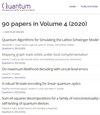量子元胞自动机的重整化
IF 5.1
2区 物理与天体物理
Q1 PHYSICS, MULTIDISCIPLINARY
引用次数: 0
摘要
我们研究了超立方晶格上量子元胞自动机的粗粒度过程,该过程包括将相邻的细胞分组为块并在每个块中选择子空间。这样做的方式是,应用于该子空间的多个进化步骤可以被视为一个新的量子细胞自动机的单个进化步骤,其细胞是子空间本身。我们推导了元胞自动机可重整性的充分必要条件,并利用它研究了元胞自动机在一条直线上的重整化流,其中元胞为量子位元,瓦片由两个相邻的元胞组成。对该问题进行了详尽的求解,并突出了重整化流的不动点。本文章由计算机程序翻译,如有差异,请以英文原文为准。
Renormalisation of Quantum Cellular Automata
We study a coarse-graining procedure for quantum cellular automata on hypercubic lattices that consists in grouping neighboring cells into tiles and selecting a subspace within each tile. This is done in such a way that multiple evolution steps applied to this subspace can be viewed as a single evolution step of a new quantum cellular automaton, whose cells are the subspaces themselves. We derive a necessary and sufficient condition for renormalizability and use it to investigate the renormalization flow of cellular automata on a line, where the cells are qubits and the tiles are composed of two neighboring cells. The problem is exhaustively solved, and the fixed points of the renormalization flow are highlighted.
求助全文
通过发布文献求助,成功后即可免费获取论文全文。
去求助
来源期刊

Quantum
Physics and Astronomy-Physics and Astronomy (miscellaneous)
CiteScore
9.20
自引率
10.90%
发文量
241
审稿时长
16 weeks
期刊介绍:
Quantum is an open-access peer-reviewed journal for quantum science and related fields. Quantum is non-profit and community-run: an effort by researchers and for researchers to make science more open and publishing more transparent and efficient.
 求助内容:
求助内容: 应助结果提醒方式:
应助结果提醒方式:


